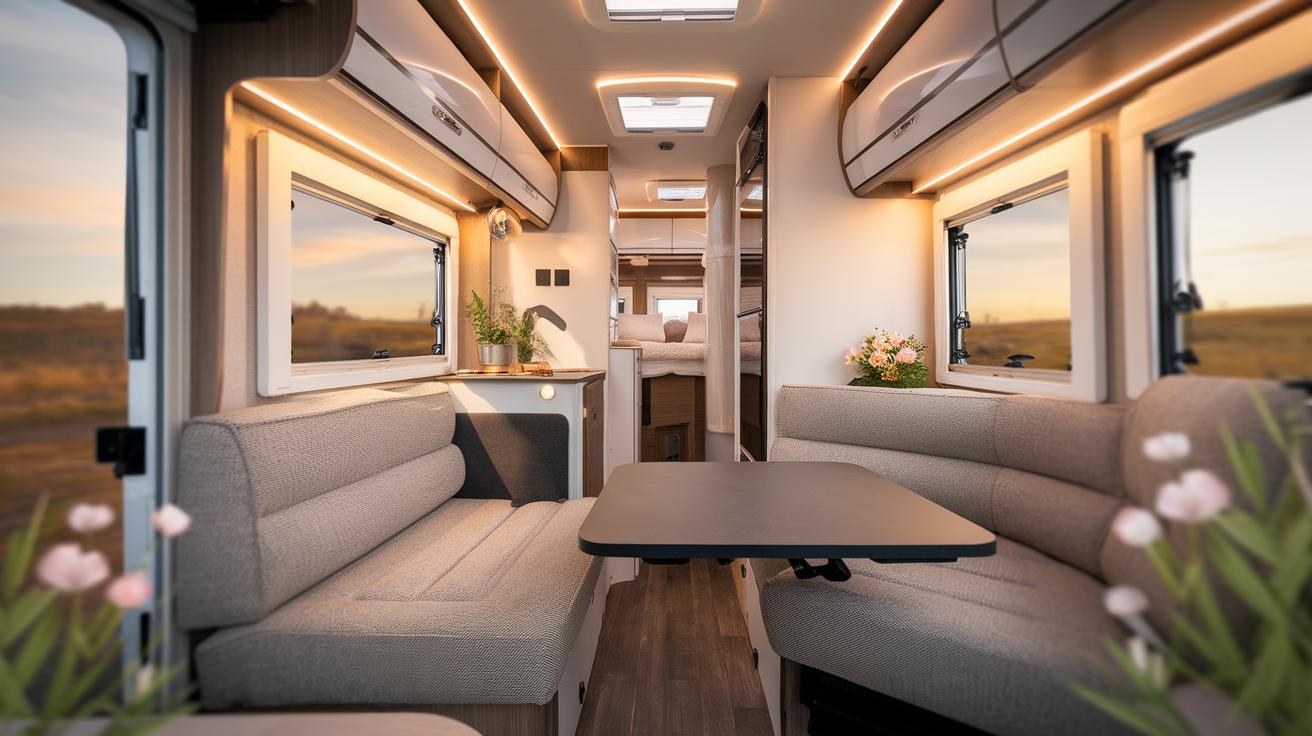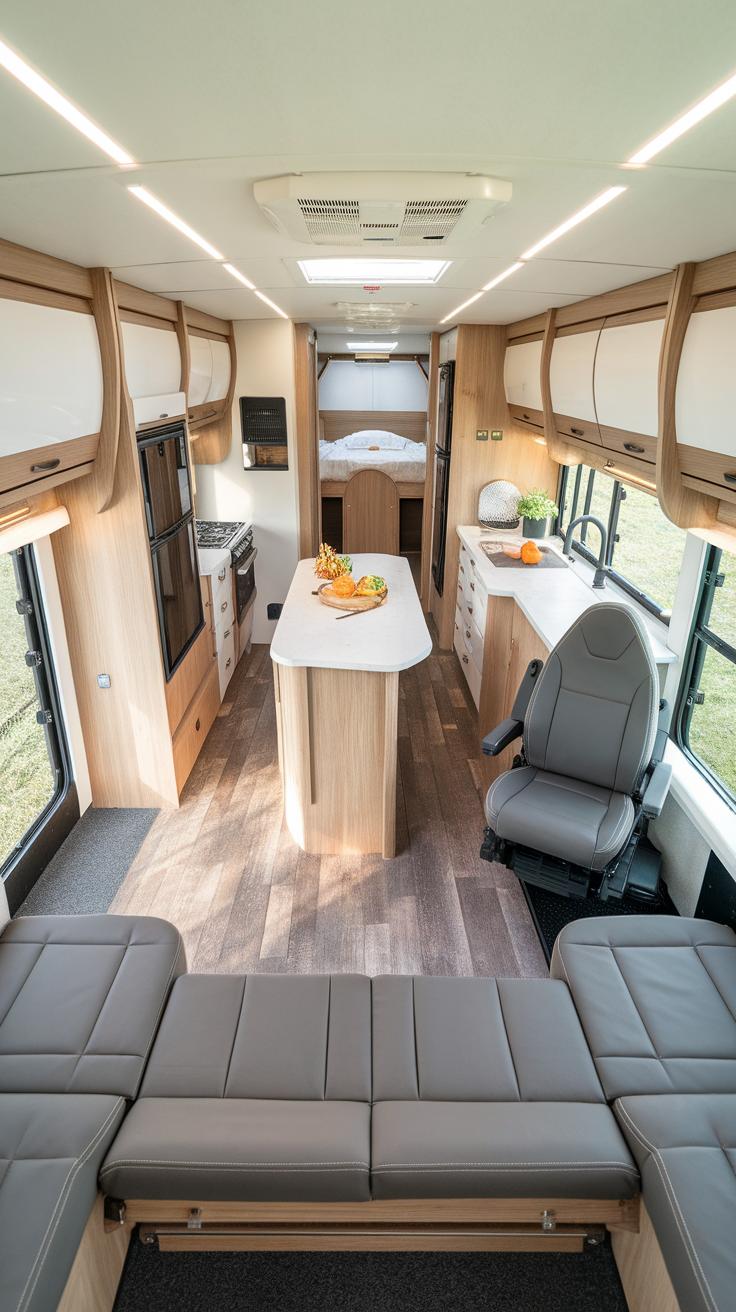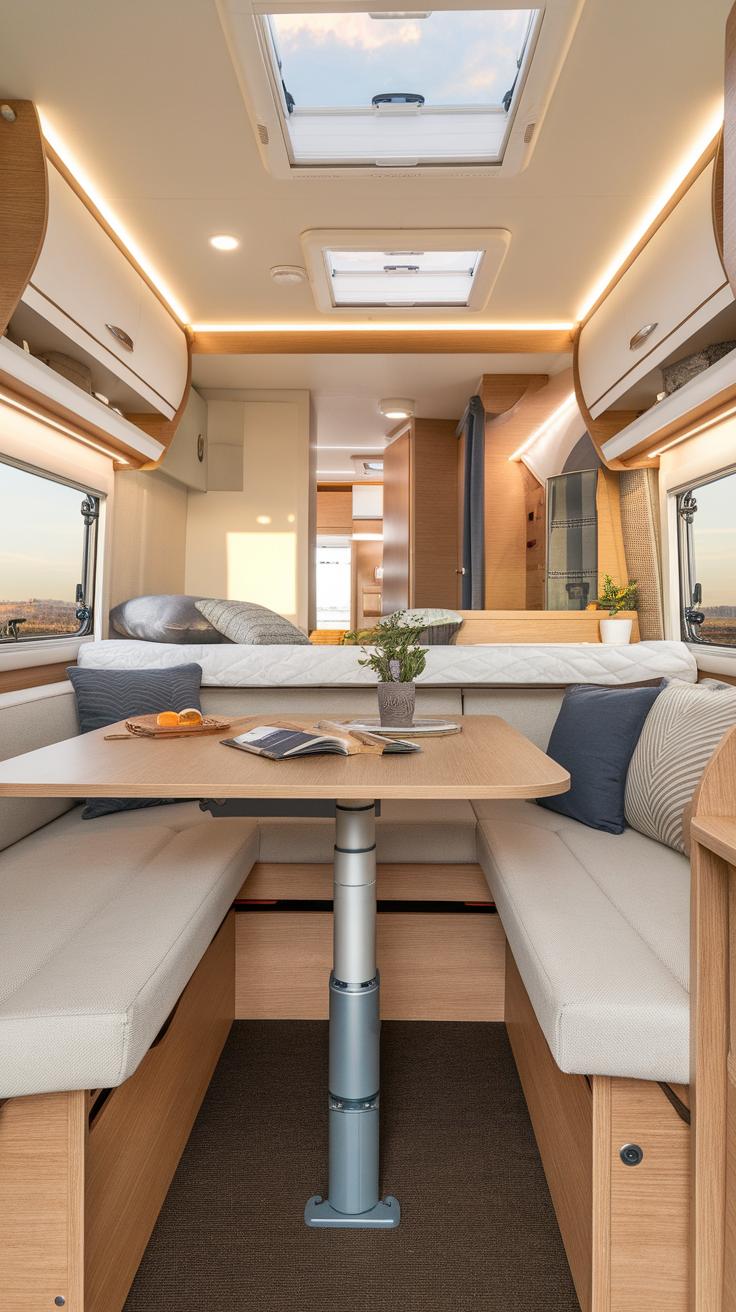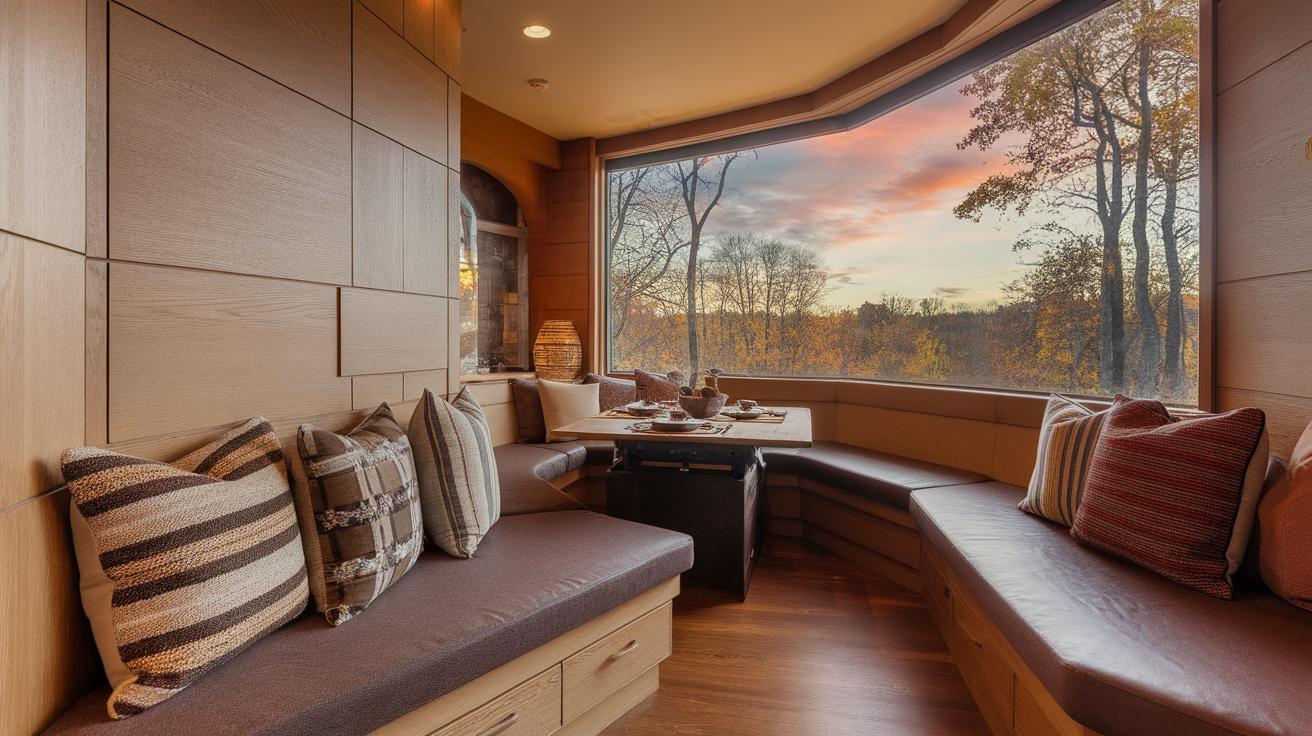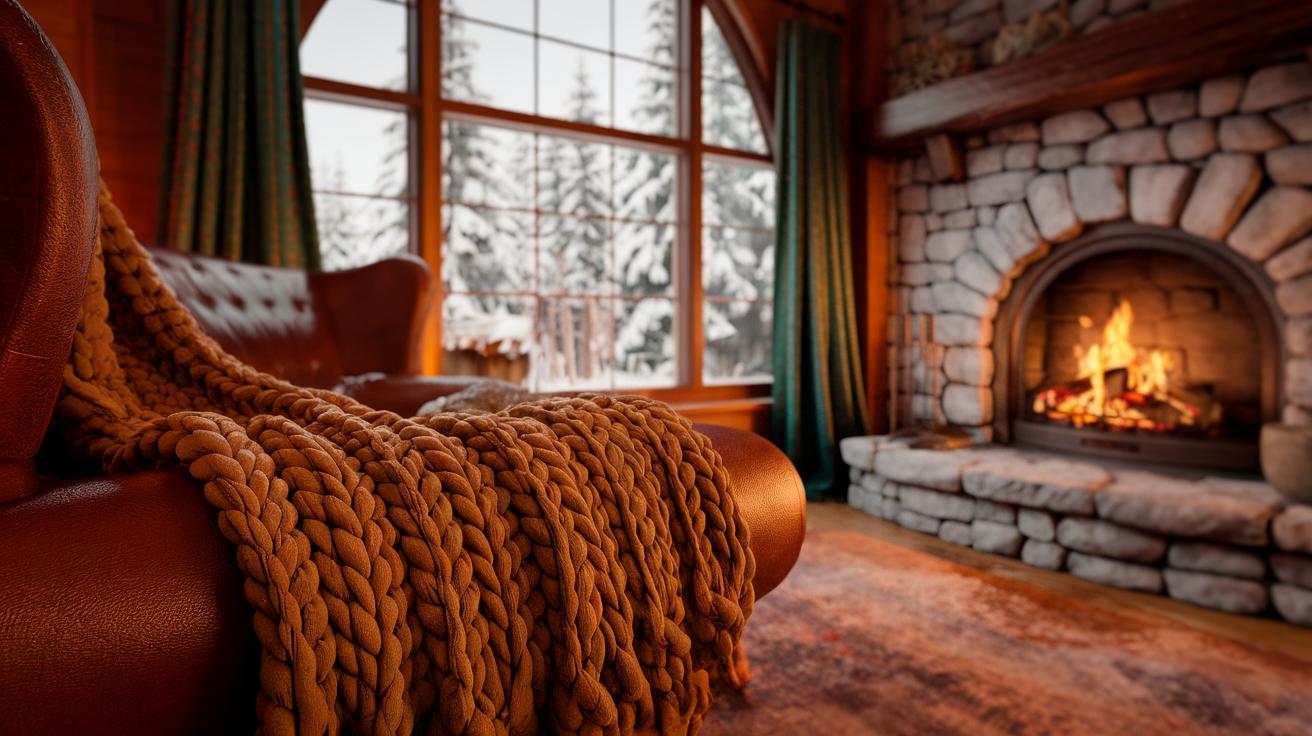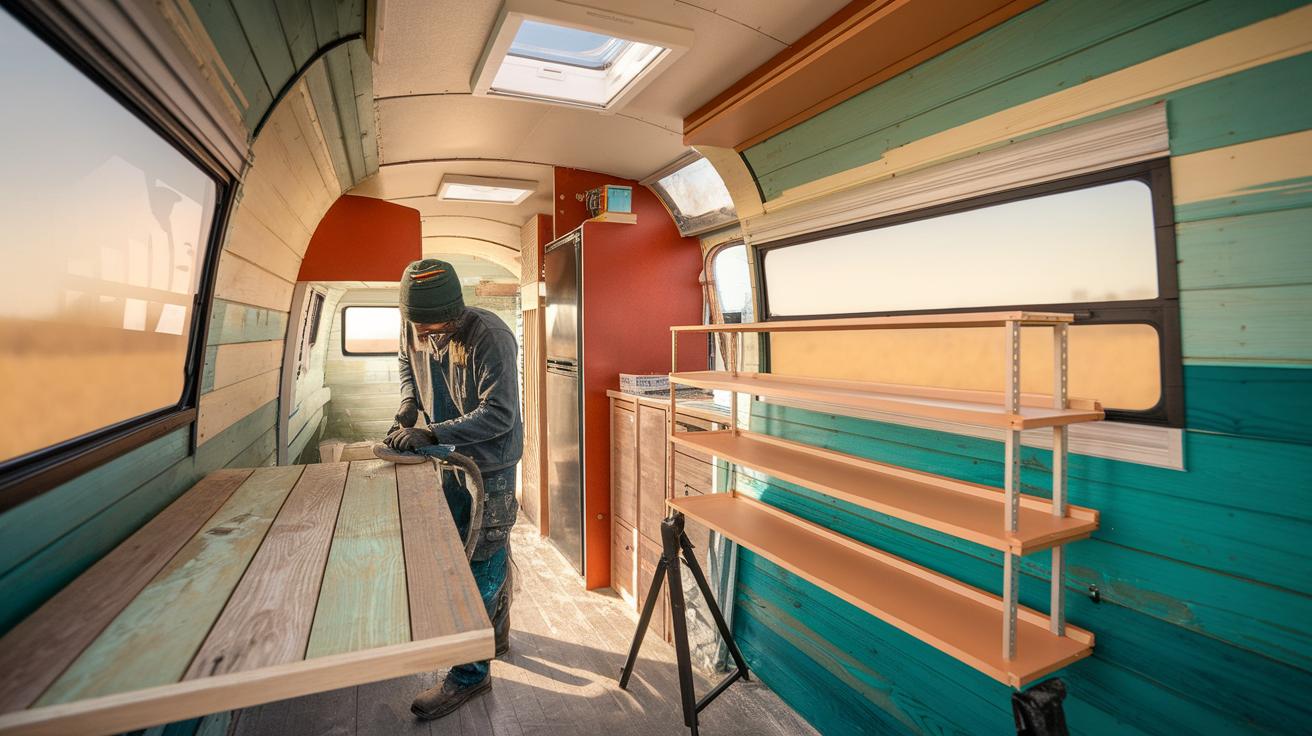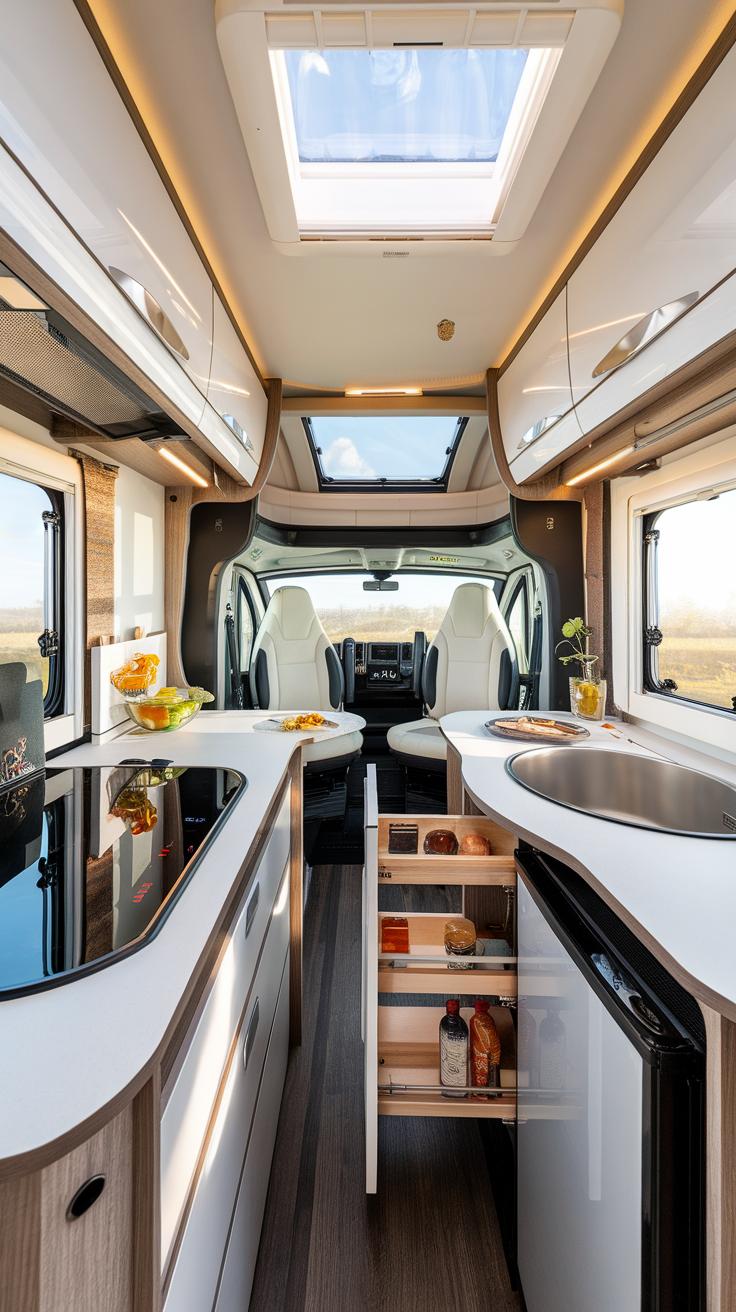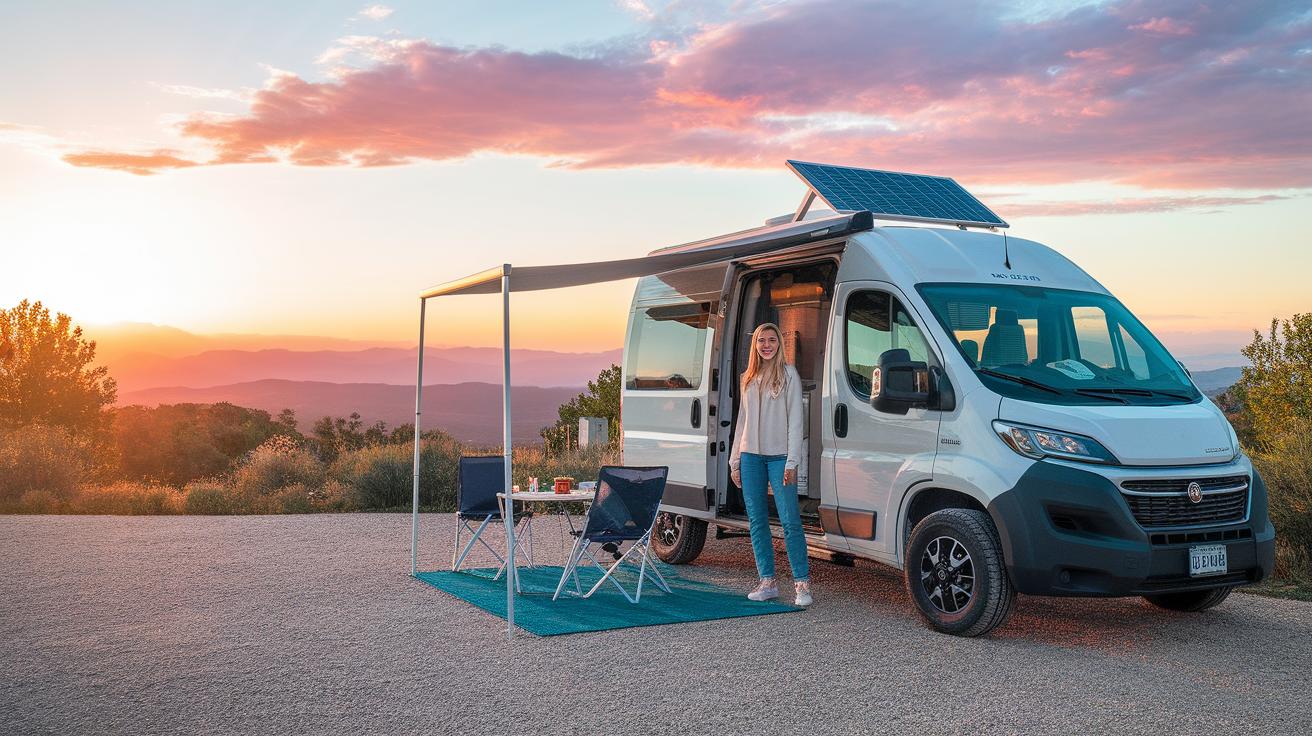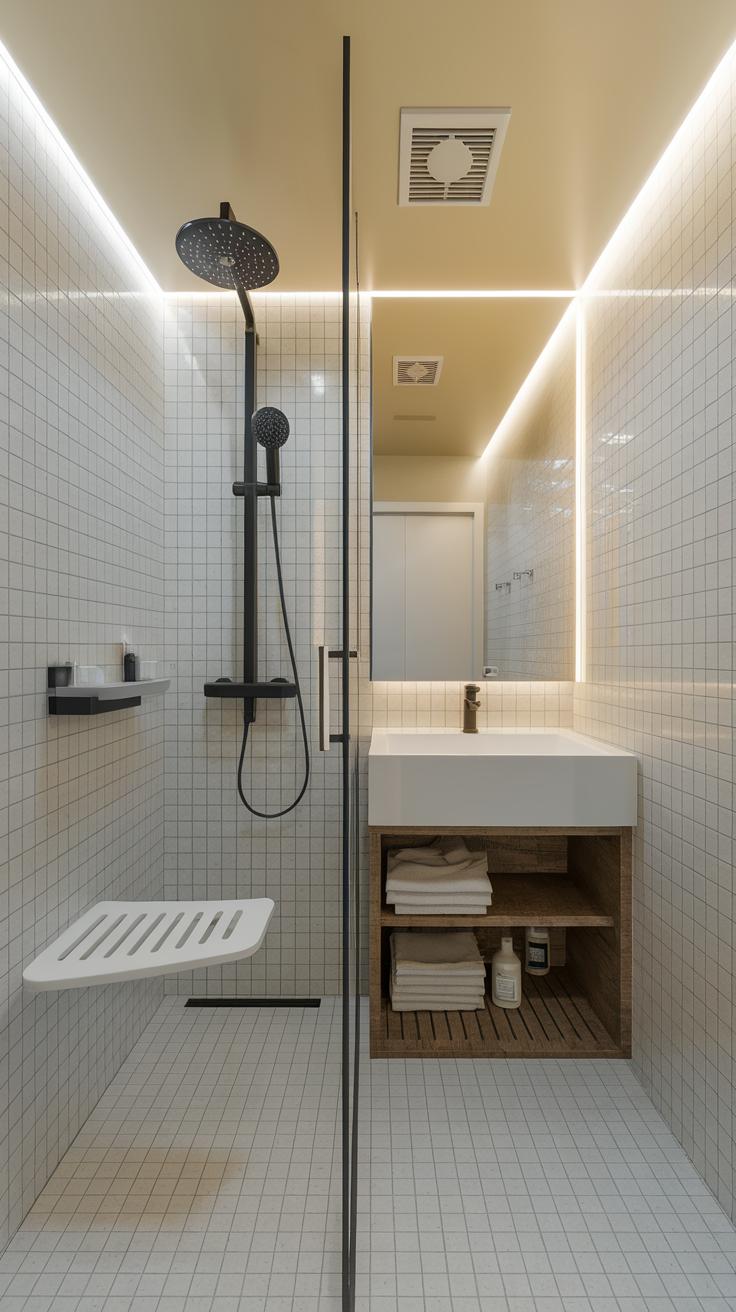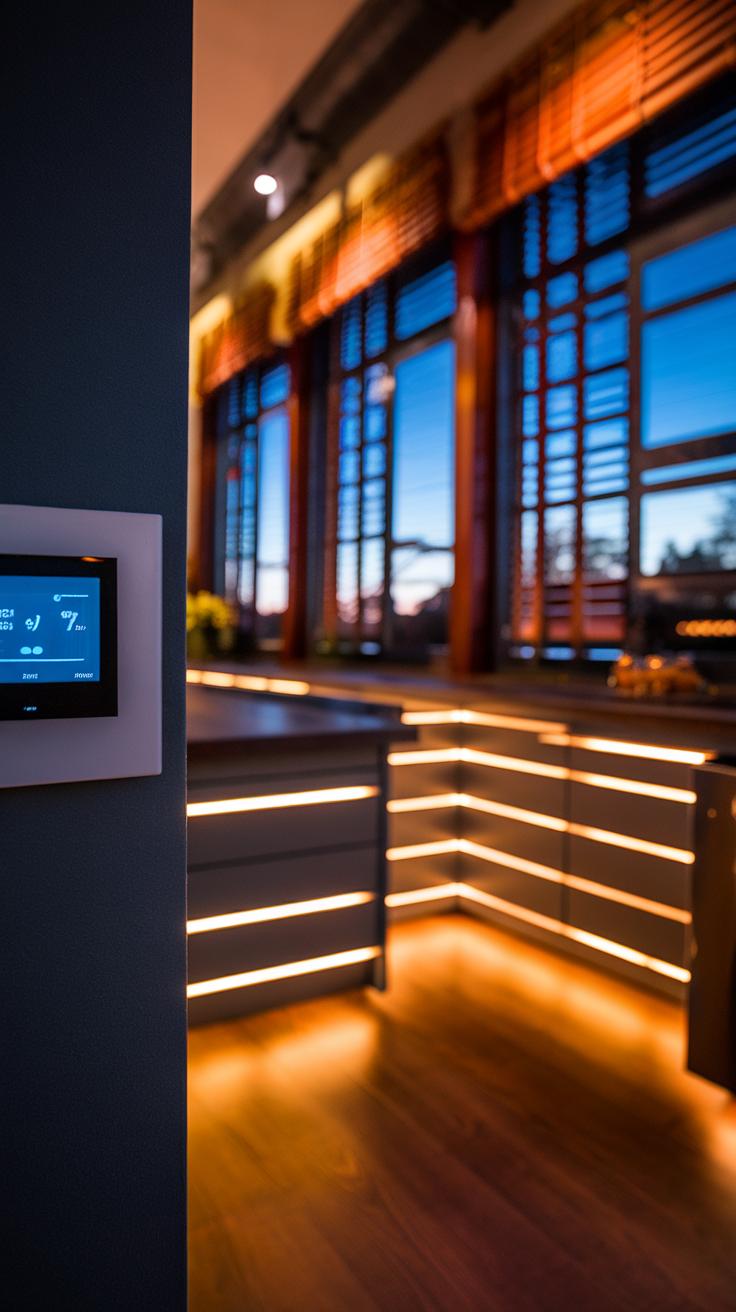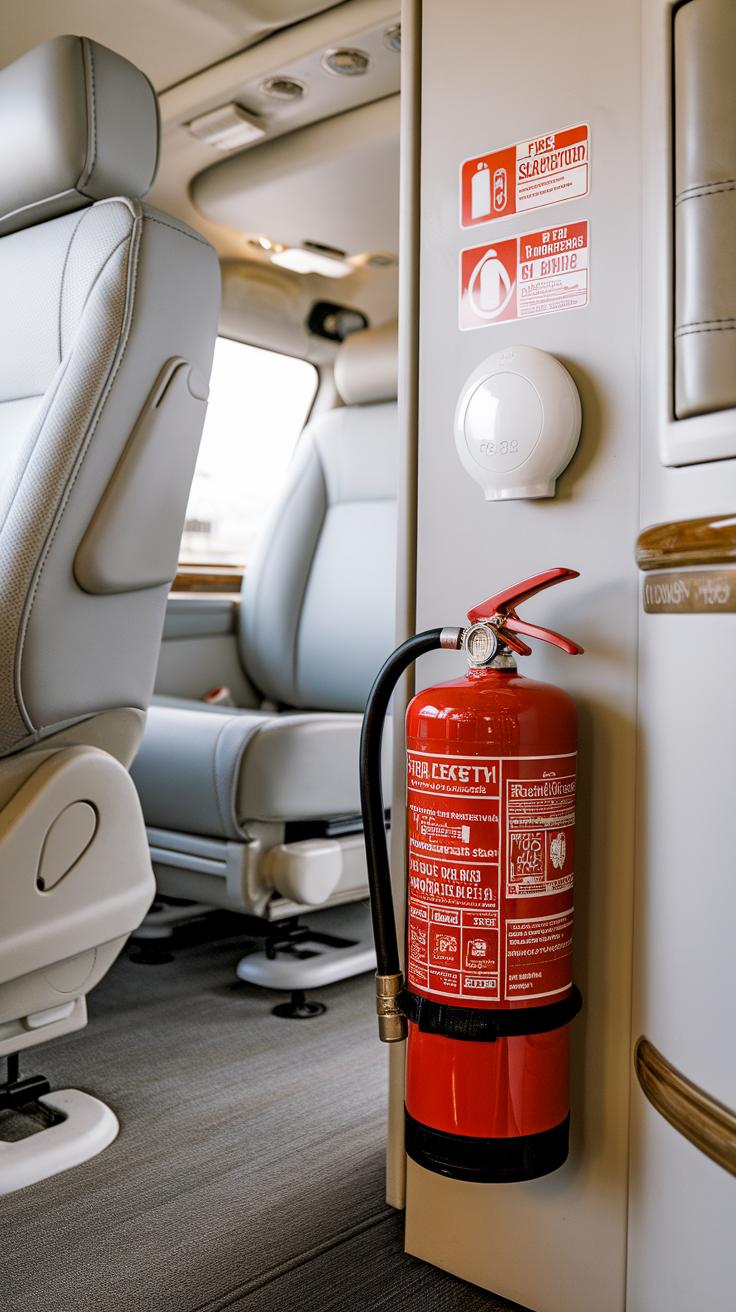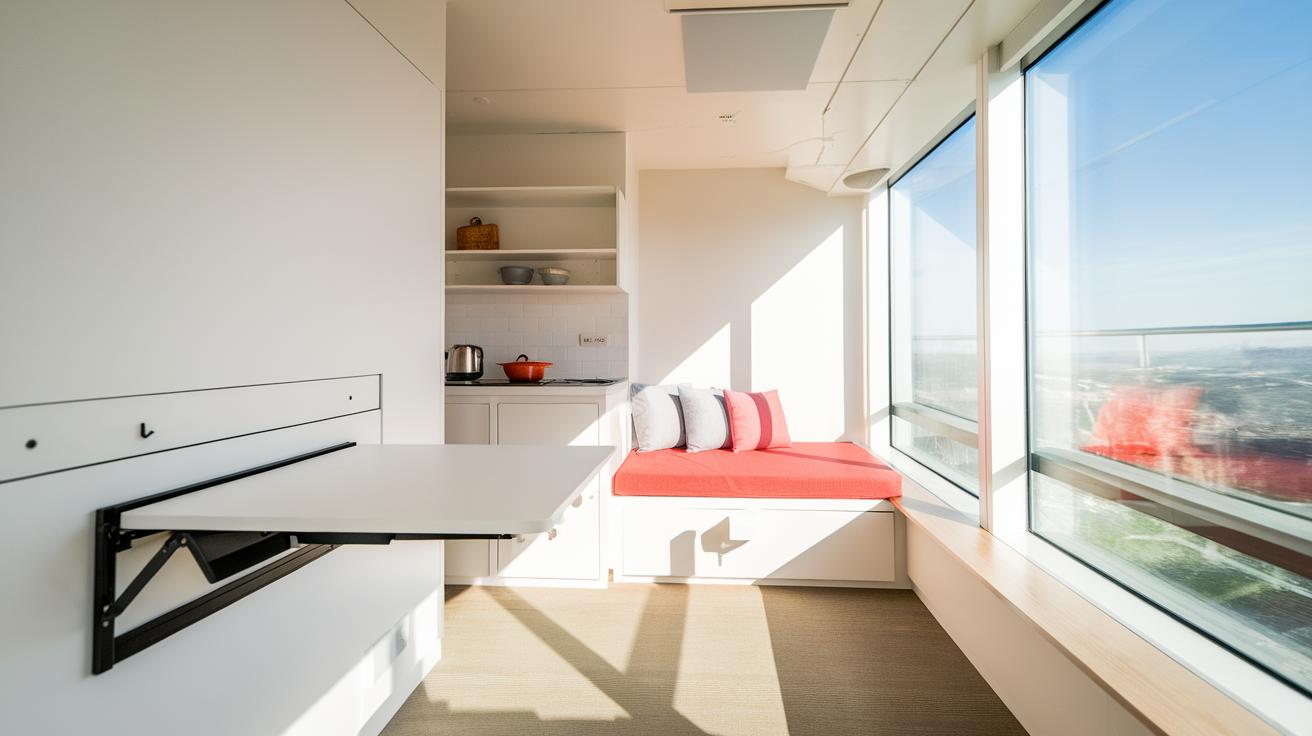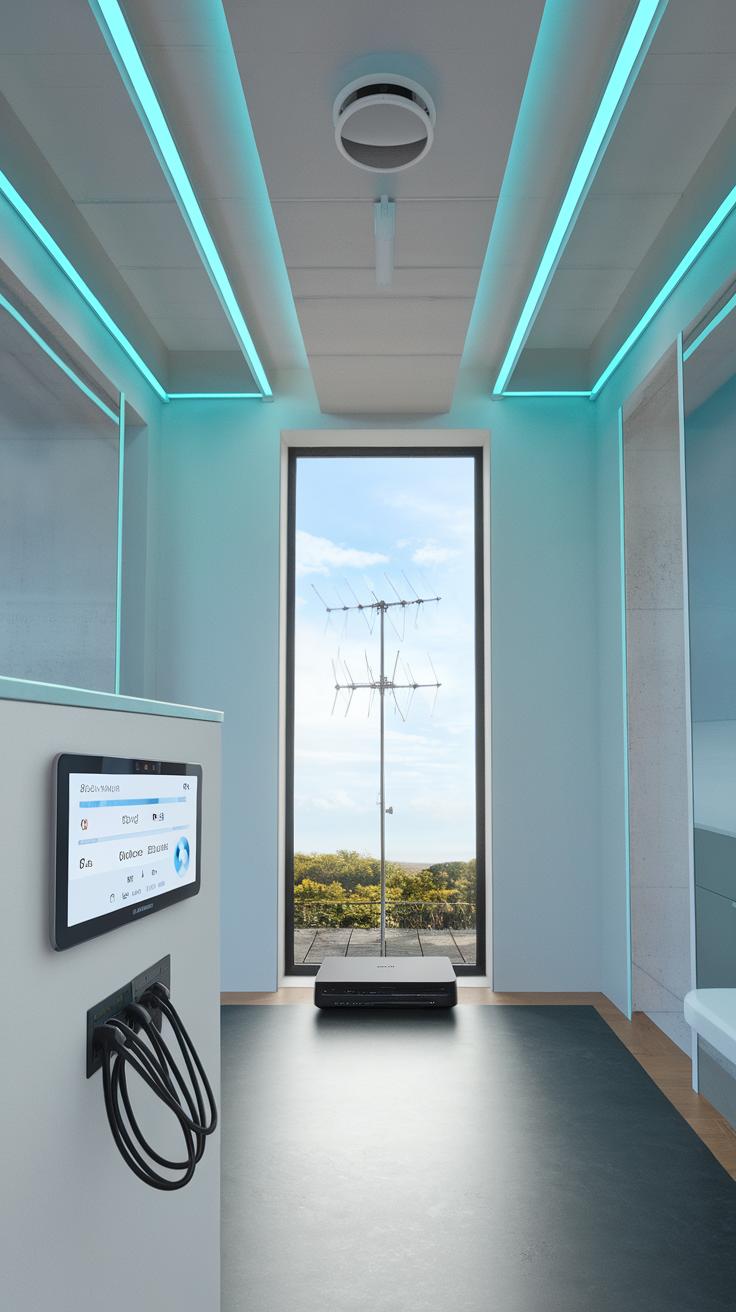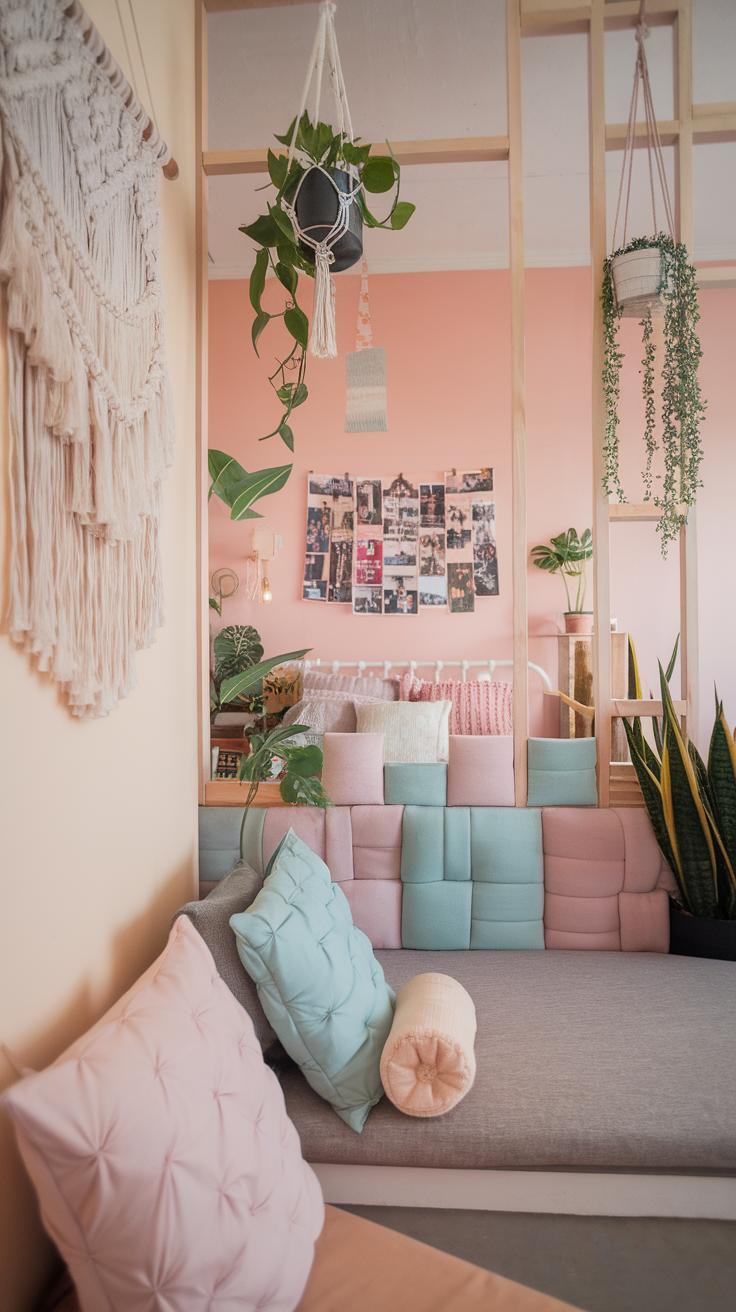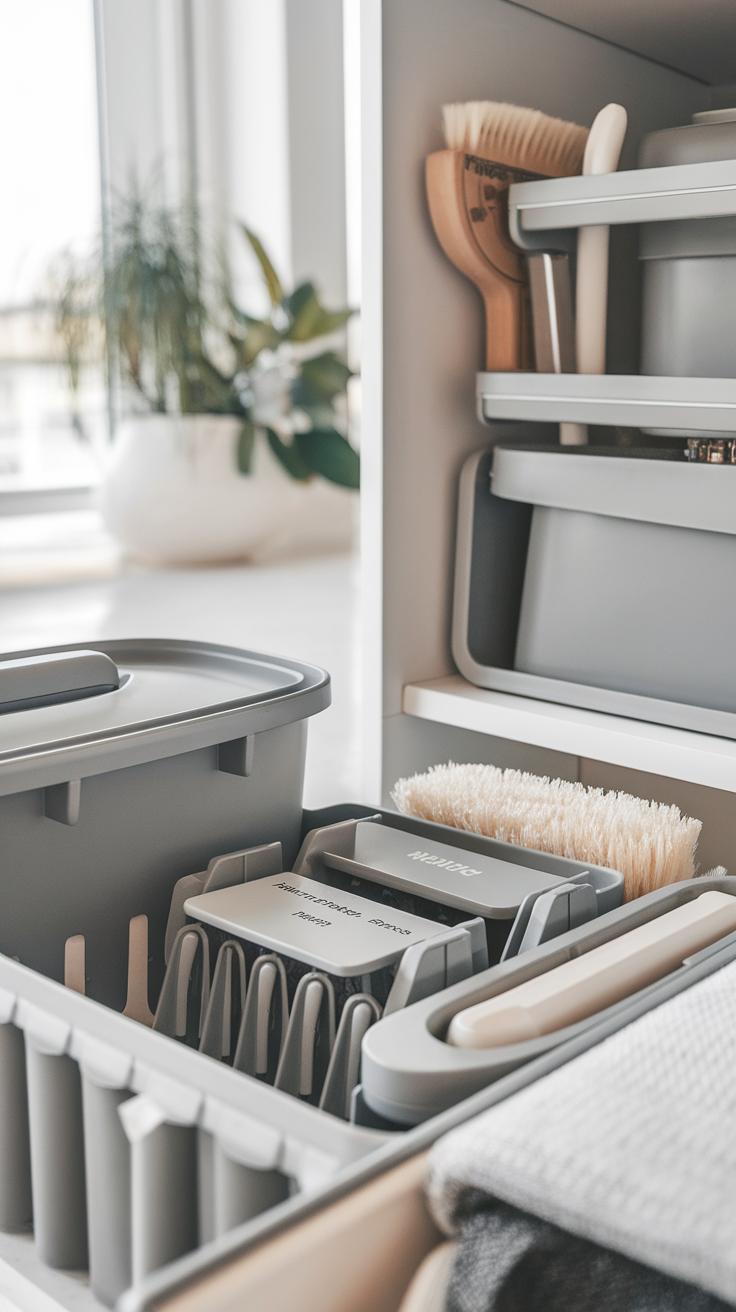Introduction
Living in a motorhome means making the most out of limited space without losing comfort. Your motorhome interior is your home away from home. It should make travel enjoyable without sacrificing the convenience and coziness you expect at home. Thoughtful design and essential equipment play a huge role in achieving this balance.
This article covers key ideas that help create a functional and comfortable motorhome interior. It is meant for anyone who uses a motorhome for travel or living. Practical advice and must-have features come together here. You will learn how to organize your space, choose the right equipment, and create a cozy environment that supports your lifestyle while you are on the road.
Understanding Your Motorhome Layout
Choosing the right layout shapes your daily life inside a motorhome. Layouts organize key areas such as sleeping, cooking, dining, and bathroom spaces. How these zones connect influences how easily you move and how comfortable you feel. For example, placing the kitchen near the dining area saves time during meal prep and cleanup. Sleeping quarters placed away from the living space offer more privacy and quiet.
Some layouts focus on open space, while others create separate rooms for different functions. The flow between zones affects your use of storage, and how many people can stay comfortably. Have you considered how you usually spend time in your motorhome? Are wide aisles or cozy corners more valuable for your trips? Understanding your layout helps you plan for functional comfort every day on the road.
Common Layout Types and Their Features
Several popular layouts appear in motorhomes, each with unique space uses. The cab-over layout has a bed above the driver’s area, saving floor space. This works well if you want extra sleeping but can limit headroom in front. Rear-lounge layouts place a seating area at the back, offering a relaxing social zone but may cut into storage space.
Slide-outs extend parts of the interior, like the living or sleeping areas, when parked. They boost floor space but add mechanical complexity and can raise maintenance needs. Choosing between these depends on your balance of living space, ease of access, and how often you move. Consider how you use your space daily before deciding which layout fits your lifestyle best.
Choosing a Layout That Fits Your Needs
Your family size directly impacts the layout that suits you. More people need separate sleeping spots and larger dining areas. Your travel style matters too: frequent stops might favor layouts with easy access to bathrooms and exits, while longer stays benefit from extra storage and living space.
Privacy can be a priority if you often travel with friends or family. Look for layouts that separate sleeping areas or create quiet zones. Storage needs vary based on how much gear you carry. Make a list of what you use daily and map out how much space each need requires. Which features will improve your comfort and make your time inside more enjoyable?
Essential Furniture for Space Efficiency
Your motorhome’s interior furniture plays a huge role in how comfortable and functional your space feels. Choosing fold-out beds can free up your living area during the day and provide a cozy sleeping spot at night. Swivel chairs allow you to change seating direction, opening up pathways and making the space feel bigger. Multi-functional tables that fold or slide can serve as dining areas or work desks, adapting to your needs without taking up extra room.
Measure your motorhome’s interior carefully before selecting furniture. Avoid pieces that crowd your walkway or block windows. Instead, pick items with slim profiles and rounded edges to improve movement. Ask yourself how you use each area and choose furniture that supports those activities without cluttering your space. When each piece fits well, your motorhome remains open and inviting, even in tight quarters.
Multi-purpose furniture selections
Sofas that convert into beds offer dual function: seating by day and sleeping by night. Tables with built-in storage let you keep blankets, books, or electronics nearby, reducing the need for extra cabinets. Some ottomans can serve as footrests, extra seating, or hidden storage units. Using multi-purpose furniture helps you cut down on the number of items you bring, making your motorhome feel less cramped.
Consider how many uses a single piece can serve. Would a bench also hold gear? Can a table double as a workspace? Each time you choose a multi-purpose option, you gain more living room. What furniture could you combine in your motorhome to fit your lifestyle better?
Material and size considerations
Lightweight materials like aluminum frames or high-quality plastics reduce overall weight without sacrificing strength. Hardwood or plywood with a veneer finish balances durability and ease of cleaning. Avoid heavy or bulky furniture that makes the interior feel crowded or impacts fuel efficiency.
Choose compact sizes designed for smaller spaces. Narrower chairs and foldable or stackable tables work well. For example, a 28-inch wide folding table fits better than a standard dining table. Check clearance around seats and doors so nothing blocks movement. Would you rather have a bulky chair or one that fits snugly without crowding? Picking the right size and material keeps your motorhome efficient and comfortable while on the road.
Optimizing Storage Space
Storage space in a motorhome is limited, so using every inch wisely matters. Under-seat compartments are often overlooked but perfect for storing items you use less frequently, like extra bedding or tools. Overhead cabinets keep essentials visible and within reach without crowding your living area. Collapsible containers pack down when empty, saving space while offering flexible storage.
Keeping your belongings organized makes daily life easier. When everything has a dedicated place, you avoid clutter and save time searching for items. Ask yourself: Can you access what you need quickly? If not, rethink your storage layout. Functional comfort comes from smart storage choices that fit your lifestyle on the road.
Clever Use of Hidden Storage
Hidden storage spots boost your capacity without adding furniture. Spaces beneath floors often hide shallow compartments ideal for storing flat items or emergency supplies. Panels behind seats or walls can open to reveal extra storage for small gear. Using these unconventional areas helps keep your living space open.
Finding these secret nooks requires planning. Are there gaps behind appliances, under steps, or inside unused cabinets that can become storage? Using hidden spaces means you store gear without sacrificing comfort or walking space.
Organizational Tools and Techniques
Bins, baskets, and divider inserts help keep items neat and separated inside cabinets and drawers. Choosing transparent or labeled bins makes it easy to find what you need fast. Dividers prevent small things from shifting while moving, protecting both your items and the interior.
Labeling is a simple step that pays off every day. When you open a cabinet or drawer, clearly marked containers let you pick items quickly. Consider grouping similar things together, like cooking tools or cleaning supplies, so you stay organized as you travel.
Kitchen Setup Essentials
Key appliances to include
Your motorhome kitchen needs a stove designed for small spaces. A two-burner propane or electric stove works well, offering enough heat to cook most meals without taking up too much room. A compact refrigerator is a must-have to keep perishables fresh. Look for models built for RV use, which handle vibrations and temperature shifts better than regular fridges. A built-in sink with a reliable water pump lets you wash dishes and prep food easily. If you enjoy convenience, consider adding a microwave for quick heating and a small coffee maker to start your mornings right.
Think about your typical meals and what appliances you actually use. Do you need an oven or just stovetop cooking? Would a toaster fit your space and routine? Prioritizing essentials prevents clutter in your limited kitchen.
Maximizing kitchen storage and function
Use vertical space by mounting magnetic strips to hold knives or metal utensils safely and accessibly. Stackable, clear containers save space and help you see your ingredients at a glance. Choose collapsible bowls and measuring cups to reduce clutter when not in use. Opt for a sink cover or cutting board that fits over the sink to expand your counter area when washing up.
Counters in motorhomes are tight, so think multi-function. Can your faucet fold down? Do your cabinets open fully without blocking your cooking zone? Keeping surfaces clear improves safety and makes cooking less stressful. What small changes could make your kitchen more user-friendly every day?
Bathroom MustHaves
Your motorhome bathroom needs to balance comfort and space. Choosing the right fixtures greatly affects how pleasant your experience will be. Compact toilets fit well in tight spaces without sacrificing usability. Showers should be just big enough to move freely but small enough to save precious room. Water-saving features are key. They cut down on water use, extend your supply, and keep hygiene consistent. Installing a low-flow showerhead or a faucet aerator helps reduce waste. Consider sinks designed to minimize splashing and draining quickly. These add both cleanliness and convenience. Small adjustments like these make your bathroom more practical, helping you stay fresh no matter where the road takes you.
Choosing the right toilet and shower
Cassette toilets mount inside the motorhome and include removable waste tanks, so emptying is simple. Portable toilets sit independently and are easy to move or store, but they take up floor space. Built-in toilets connect to your black water system, providing a more permanent solution but requiring proper plumbing. Shower size affects water use and comfort. A smaller stall uses less water and space, but you need room to move without restrictions. Installing a good showerhead that controls flow can prevent wasted water. When picking options, consider how much water access you’ll have and how often you’ll need to empty tanks. Which toilet type fits your travel style best?
Storage and ventilation in small bathrooms
Effective storage helps keep your bathroom neat and usable. Install narrow shelves to hold toiletries without cluttering space. Hooks provide spots for towels and robes, keeping them dry and accessible. Ventilation fans remove moisture quickly, preventing mold and odors. A well-ventilated bathroom feels fresher and stays cleaner longer. Choose a fan with adjustable speed or a humidity sensor for convenience. Adding a small window or vent can also improve airflow. Have you thought about how ventilation impacts your comfort on rainy or humid trips? Organized and well-ventilated spaces make daily routines smoother when living on the road.
Climate and Lighting Control
Maintaining comfortable temperatures and proper lighting in a motorhome affects how you enjoy your space. Temperature control goes beyond just having equipment; it’s about managing those tools to suit different weather and times of day. Heating and cooling devices work best when paired with good insulation, which limits heat loss in winter and reduces heat gain in summer.
For lighting, a mix of light sources creates flexibility. Bright ceiling lights help when you need full illumination. Task lighting focuses on areas where you work, like the kitchen or reading nook. Soft, mood lighting helps you relax after a long day on the road. You should think about how each lighting type serves your activities throughout the day.
How often do you adjust your motorhome’s climate or rearrange its lighting? Making simple changes can improve your comfort and energy use while on the move.
Heating and cooling solutions
You can control your motorhome’s temperature with several practical options. Portable electric heaters give quick warmth and can be moved to where you need heat most. Built-in air conditioning units cool efficiently during hot days but require power, so plan your energy use.
Fans offer an energy-saving way to circulate air and reduce stuffiness. Some models mount to the ceiling, while others sit on counters. Insulation plays a vital role by keeping outside temperatures from affecting the interior, so investing in quality insulation pays off over time.
Have you tested your heating and cooling setup in different seasons? Finding a balance between equipment, insulation, and airflow makes your motorhome livable no matter the weather.
Lighting choices for different tasks
Layering lighting in your motorhome improves usability and mood. Ceiling lights provide overall brightness for daily tasks. Adding focused task lights under cabinets or near seating helps with cooking, reading, and other close-up activities.
Ambient or mood lighting, such as LED strips or dimmable lamps, creates a softer atmosphere that helps you unwind and can save battery power by using less energy. Consider lights with adjustable brightness levels to suit mornings, work time, and evenings.
Do you have a light setup that shifts easily from work to rest? Experiment with different fixtures to match your routines and enhance your space’s atmosphere.
Safety Features and Practical Upgrades
Your motorhome’s safety depends on key equipment placed where you can access it fast. A fire extinguisher should sit near the kitchen or any cooking area, ready to tackle grease or electrical fires. Smoke detectors belong on the ceiling in sleeping and living zones to alert you early. A first aid kit is best stored in the main cabin, stocked with bandages, antiseptics, and medicines tailored to your needs. You might check it every trip to keep supplies fresh.
Practical upgrades can make life safer and easier. Installing a backup camera helps you navigate tight spots and avoid collisions, giving you more confidence on the road. Solar panels provide reliable off-grid power, keeping your devices charged without noise or fumes. Water filtration systems add peace of mind by ensuring clean drinking water wherever you stop. Could these features change how you live on the go? Think about the balance between safety and convenience you want inside your motorhome.
Basic safety equipment every motorhome needs
Fire extinguishers must be easy to reach and suited for different fire types, like kitchen or electrical fires. Place smoke and carbon monoxide detectors near sleeping areas to catch dangers while you rest. A first aid kit requires a dry, visible spot with items like scissors, gauze, and pain relievers. Include a flashlight and emergency blanket.
A multi-tool and a sturdy fire-resistant gloves add protection during emergencies. Remember to test detectors regularly and replace batteries before trips. Securing these essentials keeps your motorhome ready for unexpected situations.
Convenience upgrades for everyday use
Add solar panels to reduce reliance on campground power or noisy generators. Reliable power influences how you heat, cool, and light your space. Backup cameras simplify parking and reversing in crowded areas. They can cut down stress significantly and prevent damage to your investment.
Water filtration systems improve taste and safety, protecting you from unknown sources. Upgrading your motorhome’s door locks and windows enhances security when you’re away or sleeping. Consider smart locks or alarm systems to monitor your home remotely. Which upgrade matches your travel style and safety priorities?
Technology and Connectivity
Your motorhome can be a hub of comfort and convenience with the right technology. Navigation tools like GPS systems designed for RV routes help you find safe roads and suitable stops without guesswork. You can avoid low bridges and narrow lanes, making your journey smoother.
Reliable internet access keeps you connected for work, communication, or planning your next adventure. Devices like mobile hotspots or Wi-Fi boosters extend your signal in remote areas. Satellite communications provide coverage where cellular networks fail, offering peace of mind when you are far from cities.
Entertainment systems adapt to the limited space inside your motorhome. Compact smart TVs with streaming services replace bulky units and save room. Bluetooth speakers deliver clear sound without messy cords. Portable gaming devices and tablets suit all age groups, offering fun during downtimes without overcrowding your living space.
Staying connected on the road
Choosing the right internet setup depends on your travel style. Mobile hotspots allow you to use cellular data from multiple carriers. A Wi-Fi booster helps capture signals from campsites or cafes, expanding your range. Satellite internet works in areas where cell coverage is patchy, though it may require higher investment.
Think about how often you need reliable internet. Will you work remotely or mostly stream shows? Devices like a signal finder can help locate the strongest connection spots near your motorhome. Imagine not losing contact or missing important updates no matter where you park.
Entertainment systems for all ages
A compact TV mounted on a swivel arm saves space while allowing comfortable viewing from anywhere inside. Smart TVs can stream content directly, cutting down on extra devices. Wireless headphones let family members enjoy different media without disturbance.
For music, a small Bluetooth soundbar or speaker fills the motorhome with clear audio without clutter. Portable gaming consoles or tablets support games and apps suitable for kids and adults alike. Consider devices that charge quickly and don’t take up much storage.
How do you balance entertainment needs without sacrificing living space? Choosing multi-use devices and flexible setups helps create a cozy, engaging environment for the entire family.
Personalizing Your Space
You spend a lot of time inside your motorhome, so making it feel like home matters. Adding personal touches helps you connect with your space and enjoy your daily living. Choose decorative elements that reflect your style, such as photos, artwork, or travel souvenirs. These items create a unique environment that feels familiar and welcoming.
Color choices can change the mood of your motorhome quickly. Opt for tones that relax you or boost your energy, depending on your needs. Use paint, fabrics, or removable wall decals to introduce these colors without the hassle of permanent changes. Comfort accessories, like plush pillows or lightweight throws, increase relaxation and bring a sense of warmth.
Have you thought about what makes your current home feel right? Imagine bringing those elements on the road with you. Your motorhome should be not just a vehicle, but a personal retreat that matches your tastes and comforts. This approach keeps you relaxed and focused during your journeys.
Simple decoration ideas that enhance comfort
Cushions brighten seating areas and boost comfort. Choose washable covers in patterns or colors you like. Curtains offer privacy and soften sunlight while adding style. Pick light fabrics for summer and thicker ones for cooler weather. Removable decorations, like wall hooks or magnetic picture frames, allow you to update the space as you go.
Think about adding items that easily move or pack away. A small collection of decorative jars or plants can freshen the space. Replacing cushion covers seasonally changes your motorhome’s mood without clutter. These adjustments help keep your interior inviting, even during long trips.
How can small changes affect your mood inside a compact space? Try swapping one or two pillows or switching curtain colors. You might find simple touches impact your comfort more than you expected.
Creating a cozy atmosphere
Blankets and rugs add warmth and texture, making your motorhome feel inviting. Choose easy-to-clean materials to maintain freshness on the road. Place a rug near the door or under the dining table to define areas and keep cold floors off your feet.
Scented items enhance your space with subtle aromas. Use essential oil diffusers, soy candles, or fabric sprays. Pick scents that help you relax or stay alert depending on the time of day. Remember to keep scents light to avoid overwhelming a small area.
Do you notice how a favorite blanket or scent changes your mood at home? Bringing those same comforts into your motorhome can make travel days less tiring and relax you quickly when you stop. Creating this atmosphere supports your well-being and enjoyment while living on the road.
Maintaining Cleanliness and Order
Your motorhome feels more comfortable when it stays clean and organized. Regular cleaning stops dirt and clutter from building up and keeps your space inviting. Small spaces get messy fast, so forming simple habits helps a lot.
Cleaning daily means wiping down kitchen surfaces after cooking and picking up little messes right away. Weekly chores could include vacuuming floors, washing linens, and tidying storage areas. Which tasks feel most urgent in your space? Focus on those first to avoid feeling overwhelmed.
Clear surfaces and put things back where they belong. Try to use baskets or bins to store items neatly and reduce clutter. When everything has a spot, it’s easier to maintain order and find what you need.
Daily and Weekly Cleaning Routines
A quick daily wipe of counters, sinks, and tables keeps grime from settling. Sweep or vacuum high-traffic areas regularly. Dust vents and shelves once a week to stop buildup.
Make a list of small actions that fit your routine—such as emptying the trash or drying the sink after use. Breaking cleaning into short tasks helps prevent stress and saves time. What small routine can you add today to keep your motorhome tidy?
The key is consistency. Keeping to simple daily and weekly habits protects your space and keeps it pleasant to live in.
Choosing Easy-Care Materials and Tools
Select materials that resist stains and wipe clean quickly, like vinyl flooring or laminated countertops. Avoid fabrics that trap dirt or are hard to wash. Smooth surfaces reduce cleaning time and effort.
Look for compact cleaning tools designed for small spaces. A handheld vacuum, microfiber cloths, and a small bucket fit easily into storage and handle most tasks. When you choose tools that store neatly and work well, cleaning feels less like a chore.
Consider how easy it is to clean your furnishings before you buy. What materials and tools have made cleaning easier in your past experiences? Using practical choices in your motorhome keeps upkeep simple and your comfort intact.
Conclusions
Creating a motorhome interior with essential features means focusing on function and comfort. Every choice should support how you live and travel inside your space. Efficient layouts, smart storage, and multi-use furniture make your small area work better. Good lighting and climate control add to your comfort.
Consider your personal needs and travel habits when adding essentials. A well-designed motorhome interior lets you enjoy the open road and the comfort of home. With the right setup, your motorhome becomes more than a vehicle. It becomes a place where every trip feels like a welcoming adventure.


